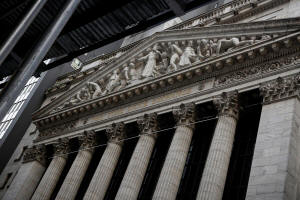Bondfires smoulder, shares struggle ahead of U.S. jobs data
 Send a link to a friend
Send a link to a friend
 [March 05, 2021]
By Marc Jones [March 05, 2021]
By Marc Jones
LONDON (Reuters) - It was a frantic Friday
for traders as another push higher in bond-market borrowing costs and
the dollar sank stocks, while oil prices jumped after OPEC and its
allies opted against increasing supply for the time being.
Nervy European shares were trying to fight back, but Asia dropped
overnight, Wall Street's S&P 500 briefly turned negative for the year on
Thursday and MSCI's all-country index was on its longest losing streak
in six months.
The latest bout of volatility was sparked when Federal Reserve Chairman
Jerome Powell on Thurday showed little alarm about the rise in yields
while lively oil markets and monthly U.S. jobs data due later meant
another busy day was in store.
"Markets were a little disappointed about what Chair Powell said
yesterday," said Henrietta Pacquement, head of investment- grade fixed
income at Wells Fargo Asset Management, referring to hopes he would push
back harder again rising yields.

If the U.S. data later comes in strong, it will add "fuel to the fire"
she said, although central banks like the Fed and the European Central
Bank, which is dealing with a more sluggish euro zone economy, do have
the ammunition to respond if yields really start to rocket.
"Perhaps the U.S. is in the best position to take higher rates, but it
will be more difficult for Europe and also EM (emerging markets),"
Pacquement said.
Germany's benchmark 10-year bond yield edged up 2 basis points to
-0.29%, holding just below near one-year highs hit last week as bond
market pressures intensified.
Benchmark 10-year U.S. Treasury yields had risen 6 bps in the half hour
that Powell spoke overnight. They were hovering at 1.55% in Europe, just
shy of Thursday's 1.56% closing level, the highest end to a day since
mid February last year.
Real yields, which take off the rate of inflation, rose 13 bps from
their intra-day lows, while yield curves resumed their steepening, with
the gap between two-year and 10-year U.S. yields at 142 bps, the widest
since November 2015.
"The move in the (U.S.) 10-year was driven by real yields (+9.5bps) as
opposed to inflation expectations (-1.3bps) which is not good for risk,"
Deutsche Bank's Jim Reid said.
PAYROLLS
S&P 500 futures were higher, having turned around overnight falls. The
tech-heavy Nasdaq Composite tumbled 2.1% on Thursday, leaving it down
about 10% from its record close on Feb. 12 and putting it in what is
known in dealing rooms as "correction" territory.
[to top of second column]
|

The front facade of the New York Stock Exchange (NYSE) is seen in
New York, U.S., March 1, 2021. REUTERS/Brendan McDermid

Even though Powell made it clear that the Fed was not close to
changing its ultra-loose monetary policy stance anytime soon,
analysts still worry rising Treasury yields could herald higher
borrowing costs, thereby limiting the fragile U.S. economic
recovery.
While Powell said the increase in yields was "notable and caught my
attention," he did not consider it a "disorderly" move.
Focus is turning to the release of February's U.S. non-farm
payrolls, with the market eyeing a 182,000 recovery in employment
growth and a steady unemployment rate of 6.3%.
"We suspect the market will be inclined to look through a weaker
number, with investors looking ahead to the big fiscal stimulus
planned in the U.S.," said Ray Attrill, head of forex strategy at
National Australia Bank.
Oil prices added to big gains after the Organization of Petroleum
Exporting Countries (OPEC) and its allies agreed to mostly maintain
their supply cuts in April as they await a more solid recovery in
demand from the COVID-19 pandemic.
Brent crude futures for May rose as high as $68.62 a barrel on
Friday, a level not seen since Jan. 8, 2020. The contract was last
up $1.83, or 2.75%, and on track for a 3% weekly gain and its 16th
weekly rise in the last 18.
"OPEC+ has kept output steady, indicating that it wants to take a
cautious approach in normalising production," said Ravindra Rao,
vice president, commodities at Kotak Securities.
Rising Treasury yields also bolstered demand for the dollar. The
dollar index jumped to a three-month high of 91.935, knocking the
Japanese yen to its lowest since June at 108.11 per dollar and
tripping the euro to $1.1930.
In emerging markets, Colombia's investment grade credit rating
looked at risk after the finance ministry jacked up its deficit
forecast and Moscow's markets were nervously eyeing reports of
Washington sanctioning Russia's government bonds.
The dollar's strength also hit gold prices, which sank to a
nine-month low as investors sold the precious metal to reduce the
opportunity cost of holding the non-yielding asset.
Spot gold was last at $1,697 per ounce, trading below $1,700 for the
first time since June 2020.
(Reporting by Marc Jones; Editing by Kirsten Donovan)
[© 2021 Thomson Reuters. All rights
reserved.] Copyright 2021 Reuters. All rights reserved. This material may not be published,
broadcast, rewritten or redistributed.
Thompson Reuters is solely responsible for this content. |